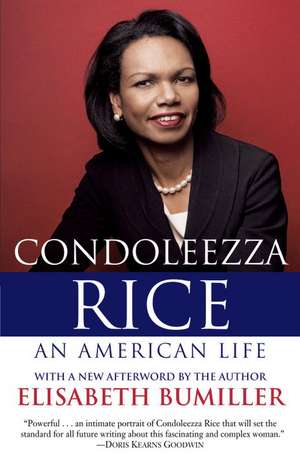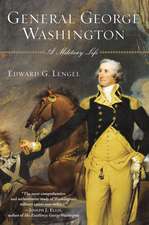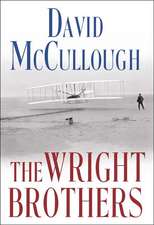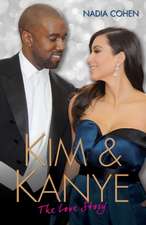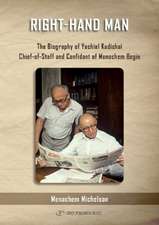Condoleezza Rice: A Biography
Autor Elisabeth Bumilleren Limba Engleză Paperback – 31 ian 2009
Preț: 125.32 lei
Nou
Puncte Express: 188
Preț estimativ în valută:
23.99€ • 24.95$ • 20.10£
23.99€ • 24.95$ • 20.10£
Carte disponibilă
Livrare economică 20 februarie-06 martie
Preluare comenzi: 021 569.72.76
Specificații
ISBN-13: 9780812977134
ISBN-10: 0812977130
Pagini: 408
Ilustrații: 16-PP B/W PHOTO SECTION
Dimensiuni: 143 x 204 x 24 mm
Greutate: 0.31 kg
Ediția:Reprint
Editura: Random House Trade
ISBN-10: 0812977130
Pagini: 408
Ilustrații: 16-PP B/W PHOTO SECTION
Dimensiuni: 143 x 204 x 24 mm
Greutate: 0.31 kg
Ediția:Reprint
Editura: Random House Trade
Notă biografică
Elisabeth Bumiller, a Washington reporter for The New York Times, was a Times White House correspondent from September 10, 2001, to 2006. She is the author of May You Be the Mother of a Hundred Sons: A Journey Among the Women of India and The Secrets of Mariko: A Year in the Life of a Japanese Woman and Her Family. She wrote much of this book as a public policy scholar at the Woodrow Wilson International Center and as a transatlantic fellow at the German Marshall Fund of the United States. She lives in the Washington, D.C., area with her husband, Steven R. Weisman, and two children.
From the Hardcover edition.
From the Hardcover edition.
Extras
Excerpt from Chapter 1
Twice as Good
Alabama, 1892-1962
The story of Condoleezza Rice begins at the close of the nineteenth century on a cotton plantation in southeastern Alabama, near the flourishing little town of Union Springs. The area was on the edge of Alabama's Black Belt, named for the rich soil and slave labor essential for cotton, the state's number one cash crop. By the early 1890s the slaves had been free for more than a generation, but so many remained as sharecroppers on the masters' plantations that planters still controlled the lifeblood of the land. New railroads that intersected in Union Springs had only made the planters richer, as their grand Victorian and Greek Revival homes attested. Now they could send their cotton to the markets in Montgomery in hours instead of the days it had taken by mule.
In 1892, according to the census records of the surrounding Bullock County, Condoleezza Rice's grandfather, Albert Robinson Ray III, was born. His father was a plantation field hand. But Albert's grandfather, at least according to Rice family lore, was the white owner of the plantation, and his mother was a favored black servant in the plantation household. The family has no written record of Alto, and there are no clues in the 1890 or 1900 Bullock County census records. Rice knows little about Alto-her great-great grandfather-or the nature of his relationship to her great-great-grandmother beyond the apparent one of sexual exploitation of servant by master common to this place and time. "I know that Alto, who was white, was either Italian-born in Italy and made it here somehow, or his parents made it here somehow," she recalled in an interview years later.
Rice also knew that one of her great-aunts, Nancy Ray, had sandy-colored hair and blue eyes. That was clear from the photographs of Nancy that Rice saw as a child, and from the recollections of her parents and grandparents. White ancestry was common to other middle-class black families in Birmingham, and across the South-one of Rice's black friends claims a Jewish judge in her bloodline-and, while not something discussed casually with outsiders, was no cause for shame. Many black household servants were taught to read, were exposed to fine things like "silver and china and linen," and came to learn "about how advantaged Americans lived," said Rice's friend Freeman Hrabowski, a Birmingham native who is now the president of the University of Maryland, Baltimore County. (Hrabowski says his great-great-grandfather was a white slave owner from a plantation near Selma.) One of Rice's friends has recalled jokingly discussing with her whose white ancestors were more aristocratic. "It was just sort of part of the landscape," Rice said.
Whatever the specifics of Rice's ancestry-the family says there were white landowners, favored household servants, and education going back generations on her father's side as well-the important point is that it powerfully shaped her view of herself as a black patrician. Any serious look at her life must begin here, in an intermingling of the races and two separate strands of American history. Rice grew up seeing herself as part of the nation's founding culture. At the least, her ancestry was a crucial part of the self-confidence that fueled her rise. She never considered herself an outsider or called herself an "African-American"-to her ears an immigrant designation she has always rejected.
"We have a racial birth defect that we've never quite dealt with," Rice said. "Which is that, really, there were two founding races-Europeans and Africans. They came here together, there was miscegenation. We founded and built this country together, and we are more intertwined and intertangled than we would like to think." She has long said that the shock over Thomas Jefferson's relationship with the slave Sally Hemmings was misplaced and naive, although she acknowledges the legacy of rape that produced so many mixed-race children in the South at the time. "It's a legacy that was basically not one of choice and volition but of violence and oppression," she said. "And so I think that's why people have trouble admitting it and talking about it and understanding it."
In Rice's family, the Italian ancestry appears to have been a source of pride, or at least was valued enough to make the family pass Italian names down through succeeding generations. Albert Robinson Ray III's brother was named Alto, and later, Albert would name one of his own sons Alto-Alto Ray, Condoleezza Rice's uncle. Two of the other children of Albert-Angelena and Genoa-also had Italian names.
Condoleezza is of course an Italian name, too, made up by Rice's mother from the Italian musical notation, "con dolcezza," which means "with sweetness." The family story has always been that Rice's mother picked the name because she was a classically trained musician and loved Italian opera. But in an interview in late 2006 Rice suggested that her name was in part inspired by the man she believes to be her Italian ancestor. "Alto, as you can tell, is an Italian name," Rice said, adding, "as is Condoleezza."
In Union Springs in the 1890s, little is known of Albert Robinson Ray III, Condoleezza Rice's grandfather, other than his likely labor in the cotton fields. Rice family lore picks him up again at the age of eleven, around 1904, when a white man is said to have assaulted his sister. Albert responded to the attack by beating up the white man, a crime so severe for a black youth that he fled Union Springs, terrified that he would be lynched. His fears were not unfounded: Like much of the South, Bullock County experienced a sharp erosion of black civil rights after Reconstruction ended in 1877. Between 1889 and 1921 in Bullock County there were seven documented lynchings.
As the Rice family tells it, Albert ended up at a Birmingham train station at 3 a.m. Somehow-the family has few details-Albert met a white family, the Wheelers, who owned a coal mine and took him in. Albert lived with the Wheelers and worked in their mine until well into his twenties.
Albert Ray may have been fleeing, but in 1904 he was also following the well-beaten path of black field laborers to "The Magic City," the name given to Birmingham only three decades after its birth.
The city had been incorporated in 1871 by ten investors who formed the Elyton Land Company in what was then the town of Elyton and bought 4,457 acres of mineral-rich property at a point where two major railroads were expected to intersect. By the start of the twentieth century, Birmingham was a booming postwar manufacturing city, named for the gritty industrial center in England, and was said to be the only place on earth where the essential ingredients of iron- and steel-making-coal, iron ore, and limestone-existed in one spot. Birmingham was heavily dependent on poor black laborers like Albert Ray, who helped fuel a growth so phenomenal that in 1904, the same year he arrived in town, the city's boosters chose Vulcan, the Roman god of fire and the forge, as the symbol to promote Birmingham worldwide. The city sent a giant statue of Vulcan as its exhibit to the 1904 St. Louis World's Fair, where it won the Grand Prize. Still the largest cast iron statue in the world, today Vulcan overlooks Birmingham from the top of Red Mountain. He has had a more recent and direct role in Condoleezza Rice's life: During George W. Bush's 2000 presidential campaign, Bush's foreign policy advisers-Rice was their coordinator-nicknamed themselves the Vulcans, after the statue in Rice's hometown. At first the name was an inside joke, but the advisers began to use it publicly because it captured the image of power, toughness, and durability they sought to portray.
In 1918, Albert Ray was still working in the Wheelers' mine when he married, at the age of twenty-eight, Mattie Lula Parham, a classically trained pianist and a graduate of St. Mark's Academy in Birmingham, an institution Condoleezza Rice later recalled as a "finishing school." Parham's father, Rice said, had been "somebody high up in the African Methodist Episcopal Church." The family does not know how Albert and Mattie Lula met, but Rice does know that they settled in Hooper City, a rural area north of Birmingham. Between the years 1923 and 1936 they had five children-another Albert, another Mattie, Angelena, Alto, and Genoa. Mattie, with her classical training, gave piano lessons to the children in the neighborhood, for 25 cents a lesson, and Albert, with no education, branched out from coal-mining to a blacksmith business and then construction. He built the house the family lived in, at 3708 Fourth Street West. As he prospered, he added on, expanding from five rooms to ten. He also dug the well, kept cows and pigs, and owned a car. The Rays were the third or fourth family in Hooper City, upwardly mobile for the time, and proud.
"I guess we might have been poor, but we never knew we were poor," Genoa McPhatter, the youngest child, said. "I can remember we always got practically everything that we wanted." The family dressed well-"Mother shopped at expensive stores for us, so consequently we grew up into clothes," McPhatter said-and had an ease with white people. "My daddy had a lot of white friends," McPhatter said, recalling how whites would come in for horseshoes to her father's blacksmith shop. "To be perfectly frank, we didn't even realize when they would come that it was segregation, because they had such a good relationship there together."
Albert and Mattie Lula sent all five children to black colleges in the South: Tuskegee in Alabama, Spelman in Atlanta, Johnson C. Smith in Charlotte. Angelena, Condoleezza Rice's mother and the middle of the five children, stayed home and graduated from Miles College in Birmingham. In the family, she stood out for her musical abilities-she played the piano like her mother-and for her sharp tongue. "She was a very sweet, kind child, but don't say anything to her," McPhatter recalled of her older sister. "If she didn't agree with what you were saying, if she felt like it was wrong, she could really lash out."
Angelena went on to teach music and science southwest of Birmingham at Fairfield Industrial High School, in a black working-class community of the same name that overlooked the massive U.S. Steel mills. Angelena was a refined presence in the scruffy town-beautiful, light-skinned, with an insistence on standard English. "The thing I remember most is she drilled us in writing," recalled Richard Arrington, Jr., Birmingham's first black mayor, who was one of Angelena's students. She taught him, he recalled, to say "had gone" instead of "had went." "Nobody had ever told me that," Arrington said. "My parents had come out of the Black Belt and we spoke black dialect in our home." One of Angelena's other students was Willie Mays, a source of family pride, which Condoleezza Rice made sure to mention in an early meeting with George W. Bush, a lover of baseball and the former managing partner of the Texas Rangers.
It was at Fairfield High that Angelena met a fellow teacher, John Wesley Rice, Jr. He was a big man, charismatic and outgoing. On Sundays he preached in Birmingham at Westminster Presbyterian, a position he had inherited from his father. The preaching job was part-time, as was common in those days. From Monday to Friday Rice taught gym and served as Fairfield's head basketball coach and assistant football coach. Although he did not have the property of the Rays, there was education and white ancestry in his family, too.
John Rice's grandmother was Julia Head, the mixed-race daughter of a white plantation owner-Condoleezza Rice's great-great-grandfather-and another favored black house slave from Greene County, in western Alabama. As the family lore has it, when Union soldiers ransacked the neighboring plantations at the end of the Civil War, Julia, under instructions from her white father, hid the horses from the Northern invaders-an act of loyalty, or at least of obedience, that the family cites today.
Julia could read and write, as could the man she married, a former slave from South Carolina named John Wesley Rice, Condoleezza Rice's great-grandfather. After the Civil War, Julia and John Rice settled as tenant farmers in Greene County, where they raised a son, also named John Wesley Rice, Condoleezza Rice's grandfather. John Wesley Rice eventually graduated from Stillman College, the historically black school in Tuscaloosa, an accomplishment of such note in the Rice family that Condoleezza Rice made it a centerpiece of a speech she gave at the 2000 Republican National Convention. In what was effectively her introduction of herself to the nation, Rice told the delegates in Philadelphia the story of "Granddaddy Rice." Her narrative, which made clear that she was from a black educational elite, set out the themes of self-reliance and godliness much admired by her Republican audience.
"George W. Bush would have liked Granddaddy Rice," Rice told the delegates. "He was the son of a farmer in rural Alabama, but he recognized the importance of education. Around 1918, he decided he was going to get book-learning. And so, he asked, in the language of the day, where a colored man could go to college."
Granddaddy Rice was told of Stillman, where he enrolled but ran out of cotton to pay for tuition after his first year. What was he to do? "Praise be, as he often does, God gave him an answer," Condoleezza Rice told the crowd. "My grandfather asked how those other boys were staying in school, and he was told that they had what was called a scholarship. And they said, 'If you wanted to be a Presbyterian minister, then you can have one, too.' Granddaddy Rice said, 'That's just what I had in mind.' "
Rice drove home her point: "And my family has been Presbyterian and college-educated ever since."
Granddaddy Rice's education encompassed literature as well. In a story that Condoleezza Rice has often told, her grandfather spent the astonishing sum of $90 during the Depression on seven leather-bound, gold-embossed books, including the works of Dumas, Shakespeare, and Hugo. When Rice's wife objected, he told her not to worry, he would pay for them over time. (In later years his niece, Theresa Love, Condoleezza Rice's aunt, would go to the University of Wisconsin and get a Ph.D. in Victorian literature.)
Granddaddy Rice's first congregation was in Baton Rouge, but the church soon dispatched him to start schools and Presbyterian congregations all over the South. By 1943, he had settled in with his last congregation, a small mission in Birmingham that became Westminster Presbyterian. In 1951, after the church had completed a new building on Sixth Avenue South, he turned over the pulpit to his son, John Wesley Rice, Jr., the gym teacher and high school coach who had earned a divinity degree, as his family expected, from Johnson C. Smith University in North Carolina.
Three years later, on Valentine's Day 1954, John Rice, Jr., and Angelena Ray were married by Granddaddy Rice in Angelena's mother's music room in the family house in Hooper City. The wedding was tiny-and held exactly nine months to the day before the couple's first and only child was born. "My mother said it was a good thing I wasn't early," Rice recalled.
From the Hardcover edition.
Twice as Good
Alabama, 1892-1962
The story of Condoleezza Rice begins at the close of the nineteenth century on a cotton plantation in southeastern Alabama, near the flourishing little town of Union Springs. The area was on the edge of Alabama's Black Belt, named for the rich soil and slave labor essential for cotton, the state's number one cash crop. By the early 1890s the slaves had been free for more than a generation, but so many remained as sharecroppers on the masters' plantations that planters still controlled the lifeblood of the land. New railroads that intersected in Union Springs had only made the planters richer, as their grand Victorian and Greek Revival homes attested. Now they could send their cotton to the markets in Montgomery in hours instead of the days it had taken by mule.
In 1892, according to the census records of the surrounding Bullock County, Condoleezza Rice's grandfather, Albert Robinson Ray III, was born. His father was a plantation field hand. But Albert's grandfather, at least according to Rice family lore, was the white owner of the plantation, and his mother was a favored black servant in the plantation household. The family has no written record of Alto, and there are no clues in the 1890 or 1900 Bullock County census records. Rice knows little about Alto-her great-great grandfather-or the nature of his relationship to her great-great-grandmother beyond the apparent one of sexual exploitation of servant by master common to this place and time. "I know that Alto, who was white, was either Italian-born in Italy and made it here somehow, or his parents made it here somehow," she recalled in an interview years later.
Rice also knew that one of her great-aunts, Nancy Ray, had sandy-colored hair and blue eyes. That was clear from the photographs of Nancy that Rice saw as a child, and from the recollections of her parents and grandparents. White ancestry was common to other middle-class black families in Birmingham, and across the South-one of Rice's black friends claims a Jewish judge in her bloodline-and, while not something discussed casually with outsiders, was no cause for shame. Many black household servants were taught to read, were exposed to fine things like "silver and china and linen," and came to learn "about how advantaged Americans lived," said Rice's friend Freeman Hrabowski, a Birmingham native who is now the president of the University of Maryland, Baltimore County. (Hrabowski says his great-great-grandfather was a white slave owner from a plantation near Selma.) One of Rice's friends has recalled jokingly discussing with her whose white ancestors were more aristocratic. "It was just sort of part of the landscape," Rice said.
Whatever the specifics of Rice's ancestry-the family says there were white landowners, favored household servants, and education going back generations on her father's side as well-the important point is that it powerfully shaped her view of herself as a black patrician. Any serious look at her life must begin here, in an intermingling of the races and two separate strands of American history. Rice grew up seeing herself as part of the nation's founding culture. At the least, her ancestry was a crucial part of the self-confidence that fueled her rise. She never considered herself an outsider or called herself an "African-American"-to her ears an immigrant designation she has always rejected.
"We have a racial birth defect that we've never quite dealt with," Rice said. "Which is that, really, there were two founding races-Europeans and Africans. They came here together, there was miscegenation. We founded and built this country together, and we are more intertwined and intertangled than we would like to think." She has long said that the shock over Thomas Jefferson's relationship with the slave Sally Hemmings was misplaced and naive, although she acknowledges the legacy of rape that produced so many mixed-race children in the South at the time. "It's a legacy that was basically not one of choice and volition but of violence and oppression," she said. "And so I think that's why people have trouble admitting it and talking about it and understanding it."
In Rice's family, the Italian ancestry appears to have been a source of pride, or at least was valued enough to make the family pass Italian names down through succeeding generations. Albert Robinson Ray III's brother was named Alto, and later, Albert would name one of his own sons Alto-Alto Ray, Condoleezza Rice's uncle. Two of the other children of Albert-Angelena and Genoa-also had Italian names.
Condoleezza is of course an Italian name, too, made up by Rice's mother from the Italian musical notation, "con dolcezza," which means "with sweetness." The family story has always been that Rice's mother picked the name because she was a classically trained musician and loved Italian opera. But in an interview in late 2006 Rice suggested that her name was in part inspired by the man she believes to be her Italian ancestor. "Alto, as you can tell, is an Italian name," Rice said, adding, "as is Condoleezza."
In Union Springs in the 1890s, little is known of Albert Robinson Ray III, Condoleezza Rice's grandfather, other than his likely labor in the cotton fields. Rice family lore picks him up again at the age of eleven, around 1904, when a white man is said to have assaulted his sister. Albert responded to the attack by beating up the white man, a crime so severe for a black youth that he fled Union Springs, terrified that he would be lynched. His fears were not unfounded: Like much of the South, Bullock County experienced a sharp erosion of black civil rights after Reconstruction ended in 1877. Between 1889 and 1921 in Bullock County there were seven documented lynchings.
As the Rice family tells it, Albert ended up at a Birmingham train station at 3 a.m. Somehow-the family has few details-Albert met a white family, the Wheelers, who owned a coal mine and took him in. Albert lived with the Wheelers and worked in their mine until well into his twenties.
Albert Ray may have been fleeing, but in 1904 he was also following the well-beaten path of black field laborers to "The Magic City," the name given to Birmingham only three decades after its birth.
The city had been incorporated in 1871 by ten investors who formed the Elyton Land Company in what was then the town of Elyton and bought 4,457 acres of mineral-rich property at a point where two major railroads were expected to intersect. By the start of the twentieth century, Birmingham was a booming postwar manufacturing city, named for the gritty industrial center in England, and was said to be the only place on earth where the essential ingredients of iron- and steel-making-coal, iron ore, and limestone-existed in one spot. Birmingham was heavily dependent on poor black laborers like Albert Ray, who helped fuel a growth so phenomenal that in 1904, the same year he arrived in town, the city's boosters chose Vulcan, the Roman god of fire and the forge, as the symbol to promote Birmingham worldwide. The city sent a giant statue of Vulcan as its exhibit to the 1904 St. Louis World's Fair, where it won the Grand Prize. Still the largest cast iron statue in the world, today Vulcan overlooks Birmingham from the top of Red Mountain. He has had a more recent and direct role in Condoleezza Rice's life: During George W. Bush's 2000 presidential campaign, Bush's foreign policy advisers-Rice was their coordinator-nicknamed themselves the Vulcans, after the statue in Rice's hometown. At first the name was an inside joke, but the advisers began to use it publicly because it captured the image of power, toughness, and durability they sought to portray.
In 1918, Albert Ray was still working in the Wheelers' mine when he married, at the age of twenty-eight, Mattie Lula Parham, a classically trained pianist and a graduate of St. Mark's Academy in Birmingham, an institution Condoleezza Rice later recalled as a "finishing school." Parham's father, Rice said, had been "somebody high up in the African Methodist Episcopal Church." The family does not know how Albert and Mattie Lula met, but Rice does know that they settled in Hooper City, a rural area north of Birmingham. Between the years 1923 and 1936 they had five children-another Albert, another Mattie, Angelena, Alto, and Genoa. Mattie, with her classical training, gave piano lessons to the children in the neighborhood, for 25 cents a lesson, and Albert, with no education, branched out from coal-mining to a blacksmith business and then construction. He built the house the family lived in, at 3708 Fourth Street West. As he prospered, he added on, expanding from five rooms to ten. He also dug the well, kept cows and pigs, and owned a car. The Rays were the third or fourth family in Hooper City, upwardly mobile for the time, and proud.
"I guess we might have been poor, but we never knew we were poor," Genoa McPhatter, the youngest child, said. "I can remember we always got practically everything that we wanted." The family dressed well-"Mother shopped at expensive stores for us, so consequently we grew up into clothes," McPhatter said-and had an ease with white people. "My daddy had a lot of white friends," McPhatter said, recalling how whites would come in for horseshoes to her father's blacksmith shop. "To be perfectly frank, we didn't even realize when they would come that it was segregation, because they had such a good relationship there together."
Albert and Mattie Lula sent all five children to black colleges in the South: Tuskegee in Alabama, Spelman in Atlanta, Johnson C. Smith in Charlotte. Angelena, Condoleezza Rice's mother and the middle of the five children, stayed home and graduated from Miles College in Birmingham. In the family, she stood out for her musical abilities-she played the piano like her mother-and for her sharp tongue. "She was a very sweet, kind child, but don't say anything to her," McPhatter recalled of her older sister. "If she didn't agree with what you were saying, if she felt like it was wrong, she could really lash out."
Angelena went on to teach music and science southwest of Birmingham at Fairfield Industrial High School, in a black working-class community of the same name that overlooked the massive U.S. Steel mills. Angelena was a refined presence in the scruffy town-beautiful, light-skinned, with an insistence on standard English. "The thing I remember most is she drilled us in writing," recalled Richard Arrington, Jr., Birmingham's first black mayor, who was one of Angelena's students. She taught him, he recalled, to say "had gone" instead of "had went." "Nobody had ever told me that," Arrington said. "My parents had come out of the Black Belt and we spoke black dialect in our home." One of Angelena's other students was Willie Mays, a source of family pride, which Condoleezza Rice made sure to mention in an early meeting with George W. Bush, a lover of baseball and the former managing partner of the Texas Rangers.
It was at Fairfield High that Angelena met a fellow teacher, John Wesley Rice, Jr. He was a big man, charismatic and outgoing. On Sundays he preached in Birmingham at Westminster Presbyterian, a position he had inherited from his father. The preaching job was part-time, as was common in those days. From Monday to Friday Rice taught gym and served as Fairfield's head basketball coach and assistant football coach. Although he did not have the property of the Rays, there was education and white ancestry in his family, too.
John Rice's grandmother was Julia Head, the mixed-race daughter of a white plantation owner-Condoleezza Rice's great-great-grandfather-and another favored black house slave from Greene County, in western Alabama. As the family lore has it, when Union soldiers ransacked the neighboring plantations at the end of the Civil War, Julia, under instructions from her white father, hid the horses from the Northern invaders-an act of loyalty, or at least of obedience, that the family cites today.
Julia could read and write, as could the man she married, a former slave from South Carolina named John Wesley Rice, Condoleezza Rice's great-grandfather. After the Civil War, Julia and John Rice settled as tenant farmers in Greene County, where they raised a son, also named John Wesley Rice, Condoleezza Rice's grandfather. John Wesley Rice eventually graduated from Stillman College, the historically black school in Tuscaloosa, an accomplishment of such note in the Rice family that Condoleezza Rice made it a centerpiece of a speech she gave at the 2000 Republican National Convention. In what was effectively her introduction of herself to the nation, Rice told the delegates in Philadelphia the story of "Granddaddy Rice." Her narrative, which made clear that she was from a black educational elite, set out the themes of self-reliance and godliness much admired by her Republican audience.
"George W. Bush would have liked Granddaddy Rice," Rice told the delegates. "He was the son of a farmer in rural Alabama, but he recognized the importance of education. Around 1918, he decided he was going to get book-learning. And so, he asked, in the language of the day, where a colored man could go to college."
Granddaddy Rice was told of Stillman, where he enrolled but ran out of cotton to pay for tuition after his first year. What was he to do? "Praise be, as he often does, God gave him an answer," Condoleezza Rice told the crowd. "My grandfather asked how those other boys were staying in school, and he was told that they had what was called a scholarship. And they said, 'If you wanted to be a Presbyterian minister, then you can have one, too.' Granddaddy Rice said, 'That's just what I had in mind.' "
Rice drove home her point: "And my family has been Presbyterian and college-educated ever since."
Granddaddy Rice's education encompassed literature as well. In a story that Condoleezza Rice has often told, her grandfather spent the astonishing sum of $90 during the Depression on seven leather-bound, gold-embossed books, including the works of Dumas, Shakespeare, and Hugo. When Rice's wife objected, he told her not to worry, he would pay for them over time. (In later years his niece, Theresa Love, Condoleezza Rice's aunt, would go to the University of Wisconsin and get a Ph.D. in Victorian literature.)
Granddaddy Rice's first congregation was in Baton Rouge, but the church soon dispatched him to start schools and Presbyterian congregations all over the South. By 1943, he had settled in with his last congregation, a small mission in Birmingham that became Westminster Presbyterian. In 1951, after the church had completed a new building on Sixth Avenue South, he turned over the pulpit to his son, John Wesley Rice, Jr., the gym teacher and high school coach who had earned a divinity degree, as his family expected, from Johnson C. Smith University in North Carolina.
Three years later, on Valentine's Day 1954, John Rice, Jr., and Angelena Ray were married by Granddaddy Rice in Angelena's mother's music room in the family house in Hooper City. The wedding was tiny-and held exactly nine months to the day before the couple's first and only child was born. "My mother said it was a good thing I wasn't early," Rice recalled.
From the Hardcover edition.
Recenzii
“Powerful . . . an intimate portrait of Condoleezza Rice that will set the standard for all future writing about this fascinating and complex woman.”
–Doris Kearns Goodwin
“A compelling portrait of the country’s first black female secretary of state . . . a cautionary tale about the gap between ambitious presidential appointees and their unwillingness to speak truth to power.”
–The New York Times
“In this singular, fascinating, well-reported, and well-written book, one of our finest journalists shows us heretofore unseen facets of the Condoleezza Rice story.”
–Michael Beschloss, author of Presidential Courage
“Measured, insightful and comprehensive . . . [Elisabeth Bumiller] brings a keen eye to Rice.”
–The New York Times Book Review
“A careful, well-documented new.”
–Los Angeles Times
–Doris Kearns Goodwin
“A compelling portrait of the country’s first black female secretary of state . . . a cautionary tale about the gap between ambitious presidential appointees and their unwillingness to speak truth to power.”
–The New York Times
“In this singular, fascinating, well-reported, and well-written book, one of our finest journalists shows us heretofore unseen facets of the Condoleezza Rice story.”
–Michael Beschloss, author of Presidential Courage
“Measured, insightful and comprehensive . . . [Elisabeth Bumiller] brings a keen eye to Rice.”
–The New York Times Book Review
“A careful, well-documented new.”
–Los Angeles Times
Descriere
Condoleezza Rice, one of most powerful and controversial women in the world, has until now remained a mystery behind an elegant, cool veneer. In this stunning new biography, a "New York Times" reporter peels back the layers and presents a revelatory portrait of the first black female secretary of state.
